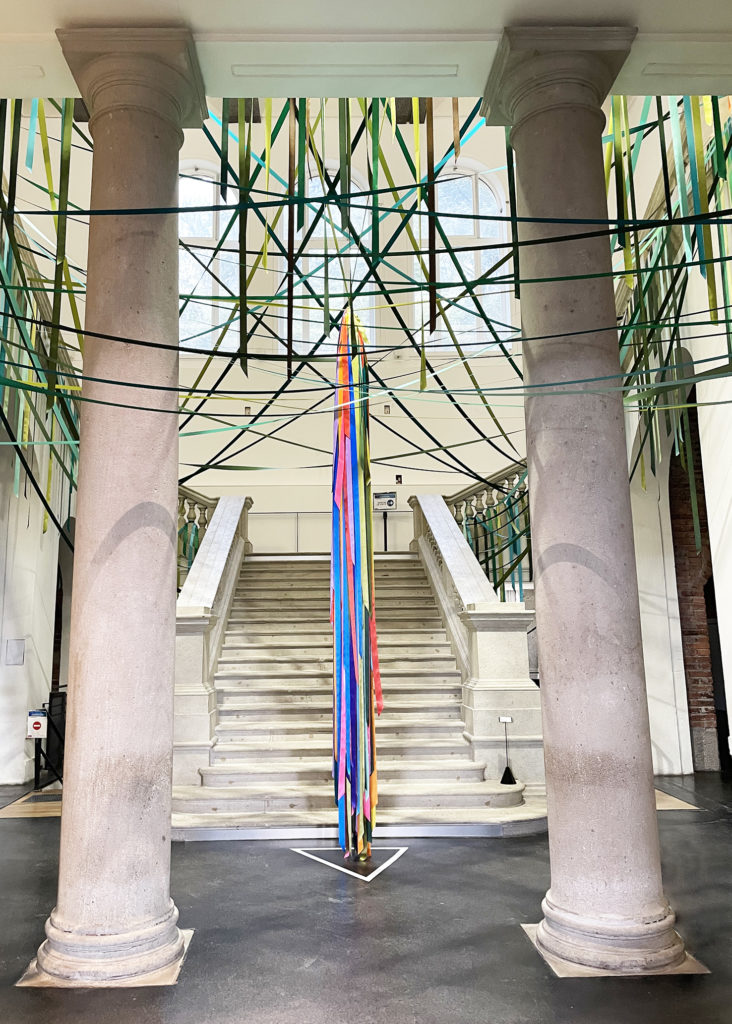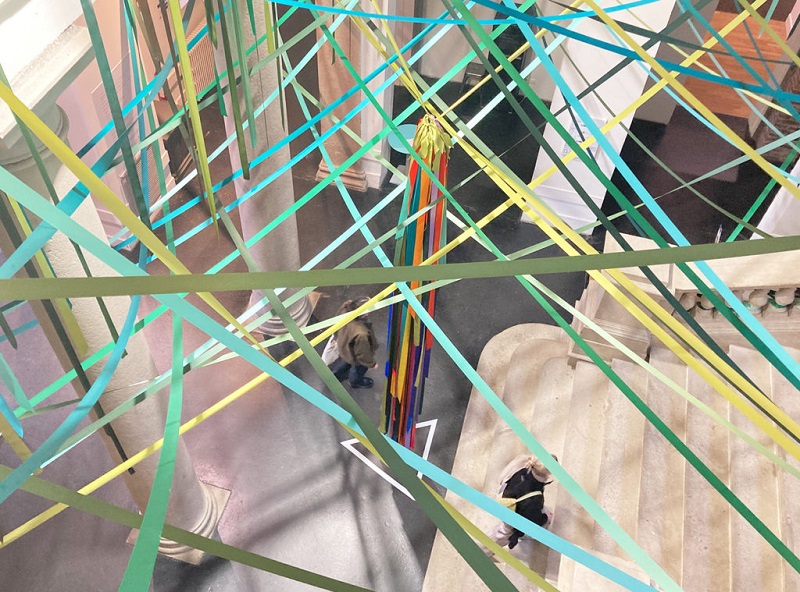The Saint-Etienne International Design Biennial has just opened its doors Saint-Etienne Museum of Art and Industry commissioned a special production from the artist Delphine Ciavaldini. This work is displayed in the central staircase of the museum. As soon as they enter, visitors are overwhelmed by a majestic, colourful work in which ribbons stretch, hang and pucker, losing themselves in a shimmering, teeming universe. The artist, who has a background in stage and costume design, presents her installation “Icibas”, made up of 3,200 metres of Satab ribbons – ref 0422 (offered as part of our partnership).
A must-see from 6 April to 31 July 2022.

We had the pleasure of talking to Delphine Ciavaldini about her work.
Satab : What is your artistic approach?Delphine Ciavaldini : I’ve been working in the performing arts for 28 years. My first job was as a costume designer, hence my affinity with textiles. Now, when I’m not working in contemporary art, I’m mostly a scenographer, hence my affinity with space and the treatment of space.
My approach is very often linked to ecological considerations in a very broad sense.
Satab : Why do you use ribbons in your creations?
D.C :
It was a specific request from the curator, it’s not at all a systematic approach. The curator had seen a previous piece that used a lot of ribbons, because I wanted to stage the party. I’d used ribbons and let them fall to the ground, as if it were a party that had fallen apart.
In fact, the characteristics of my work are to use simple everyday elements, used in their great plurality. You can easily ‘recode’ a simple element. For example, a high-heeled shoe is a complex element, but a ribbon, a tie and a pencil are simple elements. Setting up a sequence of simple elements will allow you to say something else, depending on how you arrange them.
Here (in the work presented for the International Design Biennial), you’re dealing with pure and simple scenography, with very few things, simple elements that induce a thought, a sensation.
Satab : Comment utilisez-vous les rubans ?
D.C : J’utilise les rubans comme de la peinture, comme si vous faisiez un trait au crayon. Le ruban uni a un côté signalétique très fort. Cela permet de faire un trait d’un crayon, de faire de la peinture en même temps que de la signalétique.
Satab : Tell us about your work?
D.C : Icibas is an installation made up of kilometres of satin ribbons. It takes over the museum’s grand staircase, opening up a dialogue with its monumental, mineral character. The installation draws on the ostentation of the architecture and the ascent of the visitor. On the ground floor, the room evokes a vegetal space, a jungle, a forest or an undergrowth. The satin is supple and warm. Between and echoing the two columns is a multicoloured fountain or pool. Here we can see all the colours of flowers, harvests and resources offered by nature. The fountain does not reach all the way to the top and stops just before the columns. The lianas that cover the staircase are a shade of green that turns yellow as you climb. The forest does not continue at the top of the staircase, where the green vines are replaced by flames. The display of opulence and the fact of having the means to implement it has for a time overtaken all other considerations. From below, the source seems inexhaustible, access to instant profusion irrepressible. At the top of the stairs, everything has become stunted and the burnt-out colours reveal the downside of the process. It’s grandiose when you go up, but when you get to the top it’s all over, you’ve heated up too much.
Satab : What does the word ribbon mean to you?
D.C : I think the ribbon works for me more in terms of evocation than definition. Whether it’s associated with a garment or a setting, in both cases it conveys intimacy. It implies delicacy and sophistication, care and attention. That’s what’s always captivating about ornament, is that it says so much more than the simple factual definition of the object. In the case of the ribbon, it’s the context that allows this or that meaning to unfold. The carnal and sensual aspect will be obvious if it is a fine, silky ribbon associated with the neckline of a garment, and the sophistication will be doubled by preciousness if it is associated with tapestry or furnishings. It’s a kind of visual vocabulary enhancer, as it allows for a whole host of nuances depending on where and how it’s placed.
Any last words
D.C : Thanks you !
Who is Delphine Ciavaldini?
Delphine Ciavaldini comes from a performing arts background and has been working in the stage business for 25 years. She began her career working with costumes and props, but has since branched out into set design and stage direction. Her understanding of space and its dramaturgy has strongly influenced her practice as a visual artist. Since 2012, she has been creating installations that resemble environments. The visitor who passes through them and moves around the rooms becomes a little more than a spectator. The space is given over to experience, with circulation allowing personal issues and thoughts to mingle with collective consciousnesses and memories. Delphine Ciavaldini constructs her installations from everyday materials that have already been used, and ‘recycles’ them so that they tell us something else about our daily lives, about the links that bind us to the necessities that define us.



